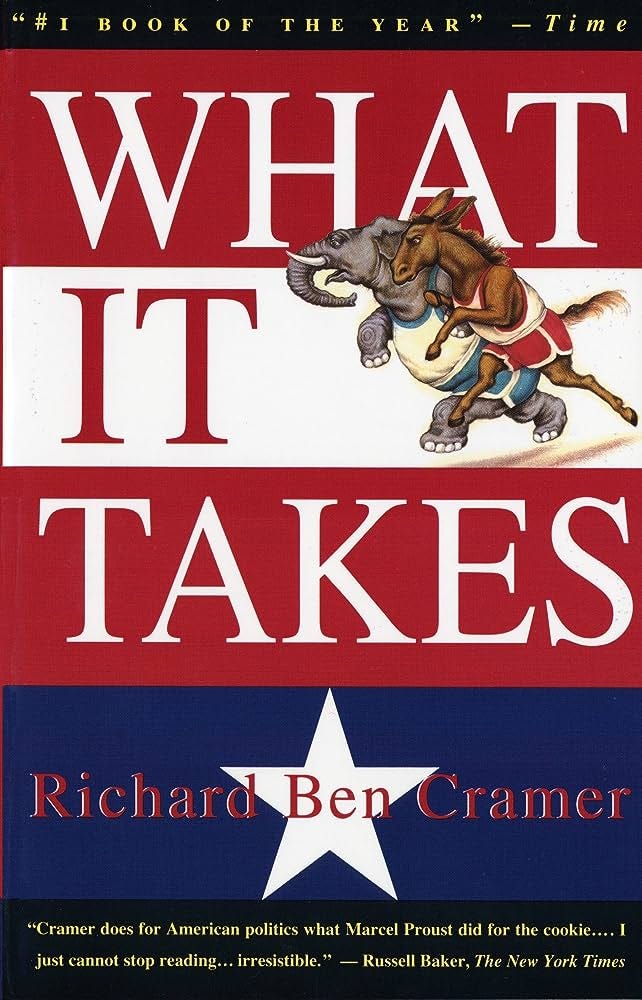Writing a Book? Read This
Part Seven: What it Takes.
What It Takes: The Way to the White House by Richard Ben Cramer is a nonfiction classic that managed to turn a humdrum presidential race in 1988 – George H.W. Bush vs. Michael Dukakis – into a brilliant portrait of six men who would be president, including Senator Joe Biden, who was bounced early in that election cycle.
The strength of the book was Cramer’s detail and insight into human nature. Even though the book was only a modest success when it appeared in 1992, it is now considered a book for the ages.
So, what does it take to a write a nonfiction book – a narrative, a biography, a memoir, an investigation – that emerges from the vast stack of books being published to be noticed, admired, and destined for readership longer than the shelf life of most books, which the humorist Calvin Trillin said was “somewhere between milk and yogurt.”
Four books this year have crossed that threshold. They are very different. As it happens, I know enough about all these authors, and the back story of their publishing history, to be able to use them to explain how writers can reach the outcome they deserve.
David Grann
David Grann’s books are blockbusters. His latest, The Wager: A Tale of Shipwreck, Mutiny and Murder, tells the story of what happened to the crew of a British warship wrecked off the coast of Chile in 1741. It is based on records, diaries, and memoirs that Grann spent years deciphering and turning into a narrative that is as compelling to read as it must have been hard to write.
That’s what David Grann does. His Killers of the Flower Moon: The Osage Murders and the Birth of the FBI, now a film directed by Martin Scorsese and starring Leonard DeCaprio, sits alongside The Wager on every bestseller list.
David has the rare trifecta of endurance, skill, and a family that recognizes the scale of his effort. His wife, Kyra Darnton, is the formidable leader of the documentary film maker Retro Report; his son, Zach, has talent in abundance as a musician/composer; his daughter, Ella, has her father’s knack for pithy insight. Watching her usually softspoken (even humble) dad on 60 Minutes, she observed (I was told), “Wow, he has charisma!” His mother Phyllis is a legendary publisher and editor.
Whatever she told David about books was certainly absorbed.
Brooke Kroeger
Brooke’s most recent book is Undaunted: How Women Changed American Journalism. The New York Times review landed the book an “Editor’s Choice.” There were so many other plaudits I lost track.
I was the publisher of three of Brooke’s books, starting with her biography Nellie Bly: Daredevil, Reporter, Feminist in 1994. She combines her depth of research with apparently limitless energy and imagination in supporting the books. When she arrived in our office with a vintage purse owned by Bly to use in promotion, I recognized authorial ingenuity. This is what I discovered about her schedule for Undaunted.
Rose Styron
Rose is ninety-five, an age when other people…Her memoir, Beyond This Harbor: Adventurous Tales of the Heart, was published recently, and an unrelated charming documentary, In the Company of Rose, is on streaming channels.
Rose’s book tells her life story from the ultimate in glamour to despair over her husband William Styron’s depressions to taking risks as a human rights investigator in some very nasty places. This New York Times profile is thorough.
Rose’s gift, among others, is friendship, just ask any of them. I am on the outer periphery of her circle, but whenever she called about the publishing process – I was not in any way directly involved – I came away with the glow of her gratitude and warmth.
Kai Bird
Kai and I are in the same reading group. He has a journalist’s flair for storytelling and a historian’s prodigious grasp of the past.
Kai’s 2005 Pulitzer Prize-winning biography American Prometheus: The Triumph and Tragedy of J. Robert Oppenheimer (written with Martin J. Sherwin) is the basis of the epic film Oppenheimer, directed by Christopher Nolan. And the book is a #1 bestseller everywhere. That a three-hour biopic of a scientist has drawn crowds of people that probably had no idea who he was reflects the power of a life story captured so deftly that it can be equally impressive in a cineplex is, well, amazing.
Here’s a glimpse of the range of interest. My seventeen-year-old grandson Peter Sanford, the morning after returning from a work-study-fun trip to Morocco, went to a San Francisco Imax to see the film and was as enthralled as his grandfather was a continent away.
Bravo, Kai!
So, what is my point? The mantra for what it takes is persistence, energy, and the ability to be as realistic about the prospects as you are determined in commitment.
And luck.




